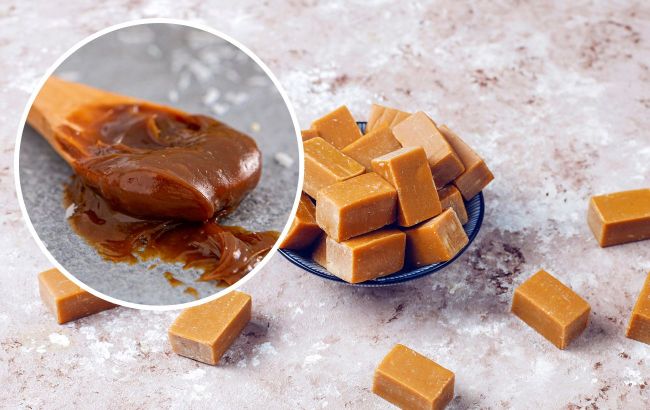Secrets to make perfect caramel - 10 tips from chefs and pastry chefs
 How to make caramel (collage: RBC-Ukraine)
How to make caramel (collage: RBC-Ukraine)
Thick, sweet, or salty caramel is used not only as a mousse or cheesecake filling but also as a standalone dessert. However, making this treat can be tricky - one needs to carefully monitor the sugar while cooking the caramel.
Here are tips on how to prepare the perfect caramel for coffee or baking.
Use only white sugar
Even if you have old brown sugar in the pantry, using it for caramel is a bad idea.
For making thick caramel, you should use refined white granulated sugar or powdered sugar.
Avoid using brown sugar or cane sugar as they contain impurities that hinder caramelization. Additionally, their brown color can make it harder to determine the crucial moment of the caramelization process.
Choose light-colored cookware with thick walls
Thin pans heat unevenly, which can cause parts of the sugar to burn before the rest has melted.
Instead, opt for a sturdy metal saucepan with a thick bottom, such as stainless steel, and high sides. The bottom should also be light-colored so you can easily observe how the caramel changes color.
Do not stir boiling sugar
While many people stir sugar at the beginning of the process, it's better not to do so.
Stirring can cause the sugar to crystallize, resulting in a grainy texture in the caramel. This can trigger a chain reaction leading to hard clumps in the caramel. Instead, gently swirl or tilt the pan during cooking.
Stirring with a spoon should only be done when mixing ingredients, such as when adding cream or butter.
Use a wooden spoon or silicone spatula
A cold metal spoon can also halt the process of sugar dissolving and turning into a smooth caramel. Therefore, it's best to use a wooden spoon or a silicone spatula.
Monitor color and temperature
It's crucial to stop cooking the caramel when it reaches a rich amber color.
If the caramel is too light, it will lack depth of flavor, but if it becomes too dark, it will taste bitter.
Add cream and butter to the cooked sugar
To soften the texture and enrich the flavor of the caramel, you can add heavy cream and butter. For every 150 grams of sugar, it’s recommended to add 70 grams of butter and 100 grams of cream.
However, this should only be done when the caramel has reached the desired deep amber color and is fully smooth.
Heat cream before adding to sugar
To avoid altering the consistency of your caramel due to sudden temperature changes, it’s important to warm the cream in a separate container before adding it to the sugar.
Butter should also be prepared in advance, ensuring it is at room temperature.
However, be careful not to overcook the sugar, as warm ingredients won’t stop the thickening process. After adding them, the caramel will continue to cook for a bit, developing a richer flavor.
Test doneness with ice water
If you don't have a thermometer, you can roughly gauge the temperature by dropping a spoonful of hot caramel into a bowl of ice water. The caramel will firm up, and its consistency will give you an idea of the temperature.
For example, if the caramel forms a soft ball, it’s around 115.5°C (240°F) - ideal for making soft candies.
If you want firmer candies, the caramel should form a hard ball, with a temperature ranging from 121°C to 126°C (250°F to 260°F).
Place the pot in cold water after cooking
Once your caramel reaches the desired level of doneness, it's crucial to stop the cooking process by placing the pot in a bowl of ice water. Otherwise, the sugar might continue to cook, becoming too dark and potentially burning.
Alternatively, you can remove the caramel from the heat when it is one or two shades lighter than you need. It will continue to cook in the hot pot.
Cook caramel over low heat
If the heating process is too rapid, some of the sugar might melt and start caramelizing before the rest has melted, leading to a grainy texture.
To prevent this, it’s advised to heat the sugar over low to medium heat. You can gently swirl the pot to distribute the sugar evenly; if left in a large mound, parts of it may burn.
The following sources were used in preparing this article: Taste of Home, King Arthur Baking, Good Food, Svitlana Klymovska’s culinary blog, and the Hoshchansk Food Products Factory blog.

